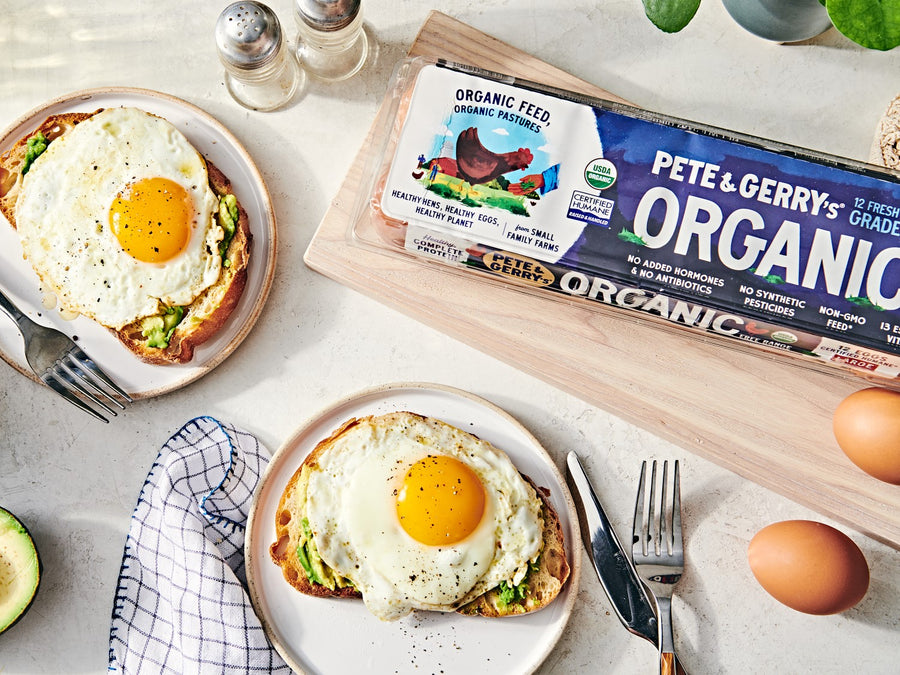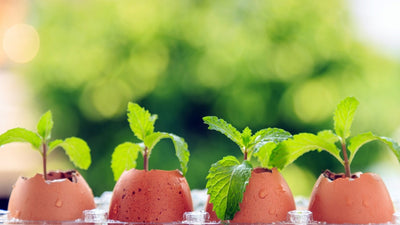
Choosing the Best Eco-Friendly Egg Carton
It's a common question around here. In fact, it's the one we get asked more than anything else: I love your organic eggs and applaud your commitment to animal welfare and sustainability on your farms, but why do you use plastic egg cartons? Isn't plastic terrible for the environment? Eggs have been packaged in paper cartons for decades. Why reinvent the wheel?
Before we first began packaging our eggs in plastic cartons back in 2012, we knew the switch would raise some eyebrows. We had a feeling the term "organic" proudly displayed on a shiny clear box might read as an oxymoron to some consumers. We didn't doubt that our inboxes would be inundated with questions from longtime loyalists. But even so, we made the switch.
Why are Pete & Gerry's Organic Eggs packaged in plastic?
Cardboard and molded paper pulp cartons have been the status quo since the invention of the first egg carton in 1911. But the saying "if it ain't broke, don't fix it" doesn't leave much room for innovation and progress, does it? We live in a very different time now; things that used to do the job just fine are being traded for their more planet-friendly, sustainable, improved alternatives, and egg cartons are no exception.
As a values-led certified B Corporation, we are diligently committed to people and the planet, so we have always taken it upon ourselves to find the best solution possible in every single area of our business.
As we began to add new partner farms to our network and extend access to our eggs across the country, we wanted to put some critical thought and research into our carton design. Choosing packaging for cargo as precious as organic eggs isn't a task to be taken lightly. That's why we went the extra mile, ultimately basing the decision on research and real data that found our cartons to be more environmentally-friendly than most other options (including paper and cardboard) on the basis of carbon footprint, human health, ecosystem quality, and resource depletion measures across their entire life cycle.
The science behind our plastic egg cartons
Most people have come to believe that plastic is inherently bad. It’s derived from a non-renewable source (oil), it doesn’t decompose for an unimaginably long time, and a lot of it continues to wind up in our oceans. It's understandable that plastic has a bad reputation. On the other hand, energy-sucking molded paper and dreaded polystyrene aren't environmental home runs either. So what’s a well-meaning grocery shopper to do?
In 2012, we hired Quantis, a Canadian research company specializing in the environmental impact of products, to do a complete Comparative Environmental Life Cycle Assessment of Egg Cartons for us. Quantis examined raw material sourcing, manufacturing, packaging, transportation, and end of life/recycling aspects for RPET (recycled plastic, like the cartons we use), virgin PET, recycled molded pulp (RMP), and polystyrene (commonly known as Styrofoam). They assigned each egg carton type a total carbon/climate change footprint score based on all those life stages. They also scored each carton type on the basis of human health, ecosystem quality, and resource depletion measures.
We went with the most environmentally-friendly packaging based off real data.
The RPET carton that we use was determined to be superior, or vastly superior, to both the molded pulp and polystyrene as a whole and across all of the individual life stages, with the one exception: it has a slightly higher manufacturing impact than recycled pulp. The worst option across almost all life stages was PET plastic made from virgin plastic, which comes as no surprise due to the high amount of fossil fuels required both as energy and raw material in its production. Unfortunately, PET is what makes up most of the soda and water bottles that are manufactured every day. Fortunately, we found a solution that not only has a low footprint, but actually removes that plastic from the waste stream: our 100% recycled RPET egg cartons.
In keeping with our ongoing commitment to a modern, science-backed approach to our packaging, we partnered with Scrapp Inc. in 2023 in an effort to better understand the impact of our egg cartons and ensure that our decision to use recycled plastic is still the best choice for our environment today. Read Scrapp's report here.
What does 100% recycled plastic mean?
If you don't feel like reading the study cover to cover but still aren't convinced that recycled plastic is, in fact, the better option, let us explain further. Rather than create new waste or use up untouched resources, our cartons are made from the plastic that's already headed for the landfill (or worse, the ocean). And although it's unfortunate, the truth is that there's a plethora of that plastic to go around. By reusing materials that are already in circulation, we’re diverting them from our oceans and landfills; giving them new life and making a decision that puts our planet first. Once used, our cartons can then be placed right back in the recycling stream for another trip through the system.
We believe we're making the right choice in reusing plastic, and we’re proud to have made that decision based on science over perceptions and assumptions.
We don't claim to be scientists, but we've done a bit of "research" ourselves, too. We've tested molded paper pulp and cardboard egg cartons on many a grocery store shelf, tracking data like egg breakage and consumer feedback closely. Through every test, our 100% recycled plastic cartons have prevailed, decreasing food waste and egg breakage through the durability of our design and the structural integrity of the material.
Frequently asked questions
Don't paper egg cartons biodegrade?
Yes! Well, under the right conditions. Unfortunately, it's not as simple as tossing a paper egg carton in your backyard and waiting for it to disappear into the soil. The reality is that the vast majority of consumers don't have access to professional composting facilities (or even backyard compost bins) that can handle the breakdown of compostable egg cartons.
Won't paper egg cartons break down in landfills?
While many people have been led to believe that paper-based materials like egg cartons will break down in landfills, that's unfortunately not the case. Landfills are compacted, anaerobic environments, which means they're void of oxygen, an essential component of biodegradation. In short, landfills are designed not to decompose garbage, but to store it.
Have you considered compostable egg cartons?
We have! We're constantly re-evaluating and improving our packaging based on what's happening in the world around us as new innovations become available. Bioplastics made from things like corn and hemp are becoming increasingly popular, but they have a major downfall: most bioplastics can only be composted in commercial composting systems. Even more frustrating, the bioplastics that end up in the recycling bin actually do more harm than good by contaminating entire batches of recycling.
How about a reusable carton?
Actually, we have one! In 2020, we introduced a reusable egg carton at our local co-ops here in the Northeast, where we also made Pete & Gerry's available as loose eggs. The COVID-19 pandemic forced us to press pause, but we plan on expanding our reusable carton program to more grocery stores in the near future.
Aren't you contributing to the problem by creating a market for plastic?
It's true that because our cartons don't involve the creation of new plastic, they rely on the existence of plastic that other companies are already manufacturing. But to be frank, those massive companies aren't going to stop pumping out water and soda bottles if Pete & Gerry's stops recycling their plastic. So until widespread changes (we're talking big, like governmental and global) arrive, we'll continue to do our part in removing that existing plastic from the waste stream.
Your study is old. Do you have any recent data?
Despite increased press around recycling, sustainability, and especially plastic in recent years, a lot of the metrics that the Quantis study relies on have not changed. In fact, recovery rates for plastic have actually improved over the last decade, an upward trend that is likely to continue. On the paper pulp side, there haven't been any improvements to the energy required for drying, which is the biggest driver of carbon dioxide emissions during this type of carton's life cycle. That's not to say that we won't consider commissioning an updated study in the future, but for now, we feel that the data still accurately reflects the current climate of the recycling industry.




